RETRACTED: The Optimization of Hospital Financial Management Based on Cloud Technology and Wireless Network Technology in the Context of Artificial Intelligence
Abstract
In the reign of Internet technology, cloud technology has emerged as one of the powerful tools in computing with many advantages in the bag. Cloud technology is defined as online access to all types of computing applications. The applications range from access to data, servers, software, databases to storage and retrieval of data. The data can be accessed from anywhere, anytime. The user does not need to own the hardware in this case. Clouds have multiple data centers located at various places. On-demand data service is the best part of cloud technology. This technology is made use in many industries. In this research, we will study how cloud technology and wireless networking technology are applied to optimize hospital financial management. The healthcare industry faces various challenges in financial management such as budgeting, growth planning, and cost-effectiveness. Considering this scenario, it is evident that there is a solid need to optimize its financial management. The cloud computing technology driven by artificial intelligence (AI) is deployed in carrying out repetitive tasks and automation, resulting in increased productivity. In this research, the proposed system uses wireless networking systems and cloud technology to optimize hospital financial management. The model works with the implementation of a hybrid of fuzzy neural networks. The proposed model is analyzed with the existing fuzzy logic and neural network models, and it is found that the proposed model has obtained an accuracy of 97.56% with minimum resources for successful financial management at hospitals.
1. Introduction
The term “nursing information competency” refers to a person’s ability to perform a wide range of information-related tasks in the nursing field. It is stated in this statement that the capacity to accomplish nursing information duties as well as the ability to practice nursing information are both required. According to the American Nurses Association, nursing staff members must have appropriate knowledge of information technology in order to participate in and lead the development of hospital information systems [1]. It is necessary to have computer skills, computer software administration abilities, and knowledge of nursing information systems because the role of NIS has changed from sickness management to nursing aid and health care (NIS) [2]. Nurses must possess the information skills listed above in order to be able to use nursing information systems in a creative manner. The ability to come up with creative ways to improve patient care and collaborate with others on ways to promote health and avoid sickness are both examples of a clinical nurse’s innovative abilities [3]. The ability to be innovative is influenced by a variety of personal characteristics, including an openness to new ideas and comfort with, or antipathy to, technological advances. The intended recipient must be able to comprehend exactly what is being stated. Despite the fact that there are numerous methods for transmitting data, keeping track of information once it is received is more complicated. Nurses’ ability to design and apply information technology to clinical difficulties is required in order to use NIS in a creative manner [4]. When it comes to NIS, nurse-initiated innovation can have a positive impact on both clinical difficulties and already-existing system procedures [5]. When it comes to monitoring nurses’ use of information technology, one strategy is to offer them feedback on how they are doing and to collaborate with the right departments to recommend ways to make it better [6]. If the present HIS is based on fixed computer terminals, nursing personnel may not be able to provide prompt diagnosis and treatment guidance, and some patient health information may have to be acquired clinically by a patient’s nurse. Patients’ health information must also be collected in a clinical setting by the medical personnel and then entered into the computer interface. Rather than being manually filled out by hospital workers, medical records at domestic tertiary care facilities should be typed in order to save time and money [7]. This can result in transcription errors, which can then result in erroneous data being recorded. As a result, the safety of patients and the consistency of their information are greatly compromised [8].
With the development of the implementation of this new cloud computing infrastructure, MNIS may now access vital data resources at any time, including a patient’s complete medical history dating back several years. The specifics of these circumstances are difficult to define, but adequate database information can be used to compare and identify the many possibilities [9]. Nurses may be able to devote more time to patient care as a result of the MNIS in the cloud computing platform, which helps them achieve “patient-centered” standards [10]. When a patient’s current complaints and symptoms are recorded in an information system, the information is saved rather than having to be manually entered into a mobile terminal at the patient’s bedside. It also saves time for medical practitioners, in addition to lowering the risk of medical errors occurring throughout the diagnosis and treatment processes [11]. Because of its critical role in medical care, the operating room is held to a higher standard of patient care than other areas of the hospital. In order to ensure patient safety and high-quality postoperative care, a number of considerations must be taken into account in the surgical operating room [12]. People’s usage of technology is influenced by a variety of circumstances, including how they communicate with one another and where they live and work. Digital administration in operating rooms is becoming increasingly vital in the process of creating a digital hospital, and it is becoming more prevalent [13] [14].
In part, this is due to the fact that private cloud computing has only been operational for roughly a decade, and so has had little impact on how nurses manage their patients’ care. At this point, nursing information technology researchers are only interested in a small portion of the cloud computing platform as a whole [15]. Patients with acute and critical illnesses are treated in a multidisciplinary operating room that includes surgery and resuscitation. The safe and effective operation of the operating room is critical to the overall success of the hospital enterprise [16]. The safety of surgical nurses is critical in today’s hospital setting. Nurses can only provide the most effective treatment and recovery if they adhere to strict procedures and standard practices, ensure that medical prescriptions are followed correctly, and execute individualized care plans. IT in surgery has the potential to improve patient care and operational efficiency while also increasing the safety of surgical team members [17]. Cloud computing in the healthcare sector is still in its early stages, owing to worries about data security and personal information privacy. For the most part, cloud computing platforms are employed for internal business operations. According to the evidence, adoption of this technology has resulted in an increase in the effectiveness and efficiency of medical treatments [18]. Due to the cloud computing revolution, it is now possible for professionals to compare and reference existing databases in order to more quickly and accurately detect medical issues such as lung nodules. The fundamentals of smart healthcare are addressed in these models, which include medicine management and the networking of medical systems. It collects and processes digital data about patients, medical equipment, prescriptions, and its own workers, which is then stored on servers inside the hospital. This information is then saved, communicated, and disseminated via technological means. As a result, researchers undertook an analysis of how smart medical system applications in China affect patient satisfaction with healthcare in order to address this hole. According to new research into smart medical systems, patients’ sentiments of self-efficacy and usefulness can have an impact on their happiness with medical treatment and outcomes [19]. The data flow and data warehousing technologies are both incorporated into the MNIS system design. The data flow paradigm allows each system node to have its own data input and output channels that are independent of one another. Because the program is well-hidden, highly coherent, and low-coupled, as more data is introduced to the data, statistical analysis is made easier [20]. This system also has the capability of keeping track of all types of data and putting it to use in a variety of different ways. There is no existing study focused on evaluating the patient’s health condition and administer the idea into product. Hence, this study focused on optimizing hospital financial management based on cloud technology and wireless network technology in the context of artificial intelligence. The paper is organized into four sections. Section 1 presents the introduction and motivation of the study. Sections 2 and 3 highlight the methods used and results of the study. Section 4 discusses the conclusion.
1.1. Motivation for the Study
Multiple people must collaborate in the traditional healthcare system to monitor the activities of patient populations, the availability of medicines, surgical materials, etc. Hospital financial management administration was also struggling to make ends meet. As a solution to problems, hospital financial management administration embraces present healthcare financial management technology advancements. Slowly, the financial management system incorporates an intelligent system that will monitor the idea into a product and the patients’ health conditions. In the proposed research, a smart quality financial management system with an identity fuzzy control model was intended. The theory is implemented using sensor data from various patients; also, an analysis will be carried out. There are specific issues with smart healthcare management and monitoring using fuzzy logic. If a single healthcare system model is insufficient to address a particular issue, two or more designs are combined to address the issue. A hybrid system is created when multiple models are combined to provide an effective solution to a problem. The combination of fuzzy logic systems and neural networks can be defined as the hybrid fuzzy neural network model (FNN).
2. Materials and Methods
Cloud technology in healthcare transforms the industry into a well-organized one and lowers the overall operating costs. With the help of cloud technology, medical data sharing and automation of processes are made more accessible and safer. It also supports the creation and maintenance of mobile healthcare applications. Cloud technology runs various critical applications which analyze and extract information’s from the structured and unstructured form of hospital data. Natural language processing (NLP) is a type of machine learning algorithm which carries out the task of reading the doctor’s handwritten records, typed lab notes, radiology readings, written medical records, etc. In Figure 1, the overall setup of the proposed system is shown. Wireless networking technology is used in hospitals to connect all the devices and servers to the cloud. The wireless sensor network (WSN) also helps automate the hospital and make it a smart hospital with the help of various sensors. The hospital utilizes the cloud database centers at various places and enhances its operation.
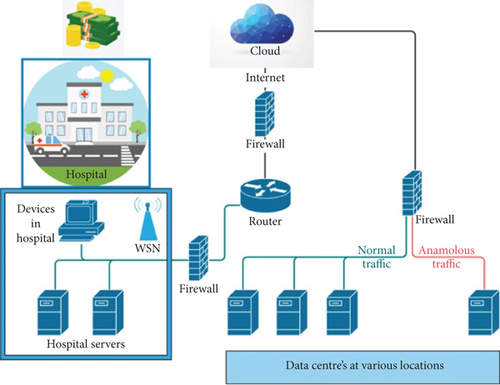
There is always a privacy concern in utilizing cloud technology in the healthcare industry because it involves the sharing of sensitive data and pieces of information with a vendor not related to the hospital. These vendors are cloud service providers who manage the hospital’s data. Even though it seems to be a disadvantage, cloud technology has many more advantages in the bag. The benefits of cloud technology in hospital finance management are shown in Figure 2. The overall operation cost is considerably reduced through various cloud technology activities. Overall operating costs are reduced because of the IT staff that work in hospitals and the hardware (servers) used by them. Access to patient data is easier and faster when compared with traditional methods, which increases productivity. Tele-health and virtual health care can be carried out easily, thus reducing the cost incurred in running the hospital. Electronic health records (EHR) are applications that provide increased scalability, thus resulting in increased hospital capacity. There is no need for extensive networks, and complex data security is needed so that the hospital fraternity (doctors, nurses, and healthcare staff) can easily and quickly access the patient’s data. On the flip side, patients also get proper medications and treatments on time, which is the main motto of any healthcare industry. The medicine and drug inventories are appropriately maintained and automated. The information about the medication adherence of the patients is kept on track. Medical record maintenance is ordered and automated when compared to traditional methods. Cloud technology provides scheduling, registration, medical records, billing, claims, clinical, financial, accounting, nursing, etc. Thus, hospital finance management is optimized by reducing the overall resources used and automating various processes. The overall operating costs of hospitals are considerably reduced with cloud technology, wireless network systems, and AI techniques like NLP.
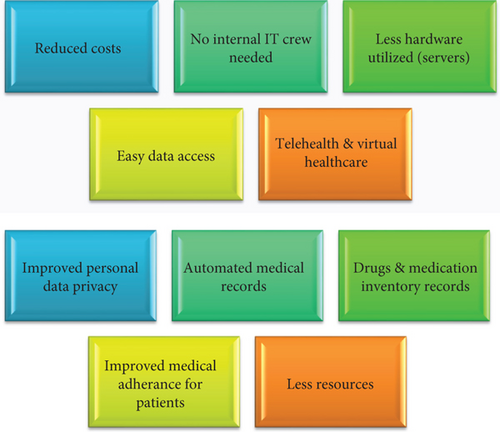
The fuzzy rule component f[n′(k)] is computed by Equation (1) to analyze the fuzzy rules. The data device is a basic predecessor that stands to gain the unit d(n(k)). The unit (g[k, k + 1]) conveys with the behavioural control. The operation concludes with a neutralized mixture.
An normal neural net is a simple neural net that makes use of redundancy, inclusion, and the Sigmoid function f. A set of fuzzy rules was developed again for decision support system use in intelligence health records. These rules are based on both factual and fuzzy data. Here are some instances of fuzzy rules.
In which, βi represents the fraction of the transmit power frequency band occupied by a terminal capable of receiving tasks, gn,i represents the link economic collapse correlation among entry point but also terminal, and Xn represents the founding network’s transmission rate.
The primary goal of optimizing an online hospital financial management system predicated on network edge is to obtain its task information systems offloading structure with the shortest time delay, which consists of two bits: digital tech time delay on only local and frame clients.
3. Results and Discussion
The neural system discovers the f [n, n + 1] procedure as part of the self-gained through fuzzy inference. Using the time period denoted by k and the structure condition k + 1. It should produce f (n + 1). A stochastic modifying module not only increases the authority of a fuzzy role with f(k) but also generates a final product. Figure 3 depicts the variation through information recorded by hospital financial management based on cloud technology and wireless network technology.

The data ranges are also calibrated using Tables 1 and 2. The input data is not only recorded but also calibrated before fuzzy logic is used to make decisions about medical illness in the second step. Table 1 displays the weighted correct output again for data entered by the user.
| No. | Location ID | Range from either the hospital financial management in kilometers (BVH) | Selectively in sample result | Testing period of financial management |
|---|---|---|---|---|
| 1 | Loca-4 | 19 | 5 | Oct 2021 |
| 2 | Loca-1 | 25 | 3 | Nov 2021 |
| 3 | Loca-7 | 37 | 2 | Jan-2021 |
| 4 | Loca-3 | 44 | 4 | July – 2021 |
| 5 | Loca-5 | 37 | 1 | Sep-2021 |
| 6 | Loca-2 | 15 | 3 | Aug-2021 |
| 7 | Loca-6 | 64 | 1 | Feb – 2021 |
| Patient information | Training values (%) | Testing values (%) | Accuracy (%) |
|---|---|---|---|
| Online transaction with networking | 85.23 | 87.56 | 97.35 |
| Mobile technology | 95.45 | 96.56 | 98.57 |
| Patient bill generation (on or off) | 96.46 | 98.46 | 99.34 |
| Bill transaction | 78.23 | 82.23 | 92.35 |
| Successful transaction | 100 | 100 | 100 |
| Automated information transaction | 98.93 | 99.35 | 99.98 |
The following emergency circumstances are monitored: Sensor data differences are obtained defines the range of hospital finance management. The cloud rate is the primary determinant of critical health conditions. The information on experimental investigation and data analysis for hospital financial management transmitter is the most widely used and investigated detector in the patient safety and management field.
To calculate the patient information in hospital financial management for online transaction in fuzzy logic manufacturing (Equation (3)), the neuron employs its transfer work f(y), which can be a nonlinear function result , as shown in Equation (4) based on this to represent in Figure 4. Sensors are used in this technique to assess the patient’s condition under analysis (refer Figure 4). The scheme used a body of knowledge and fuzzy logic system for decision support for patient care, supervising, and management to determine possible circumstances and cures. The fuzzy logic technique also tried to improve the performance of this system for patient monitoring and treatment in terms of the time, cost, and workforce consumption.
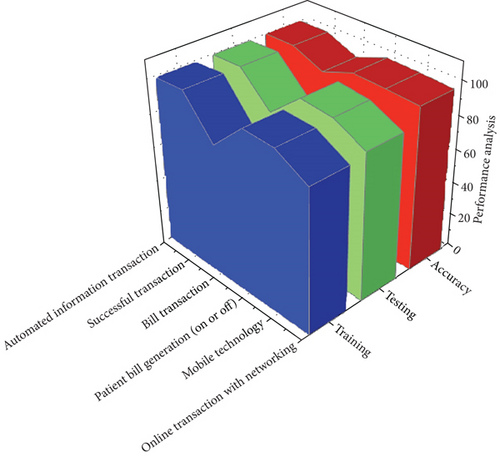
The patient document measure that is generated just on server within a week of receiving information recorded via sensors and forwarded via smart device. The divided into three segments: data from the patient, location information, and the patient’s illnesses. Table 2 contains information about just the locations we chose to test the model. Testing will take place in nearly eight multiple places. The selected establishments’ location from and testing time frame range.
For which,refers to its terminal gi knowledge processing’s ability to coordinate tasks on a regional basis. As a result, the overall time delay recognized by gi scientists is depicted in the equation only at the small level based on this to define as Figure 5. The strategy incorporates patient monitoring to sensors and demonstrates high precision and efficiency gains in comparison to the systems currently in use (refer Figure 5). The investigation was conducted on a small sample population and proved to be efficient, precise, and efficient again for purpose. The approach has so far been generalized, and it is possible to customize it for more serious condition such as cost of operating room patients, intensive care patients, newborn, and much more complex patients in hospital financial management in utilizing cloud technology.
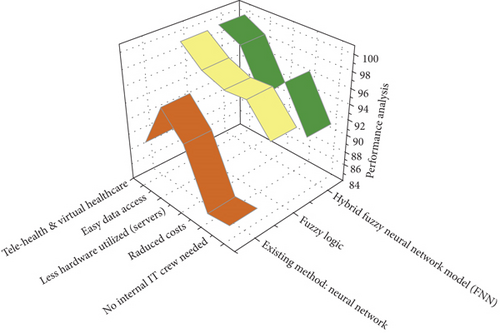
A privacy problem in using cloud technology in the healthcare industry is the transmission of sensitive data and information to a vendor unrelated to the institution. These vendors are cloud service providers who manage the hospital’s data. Even though it appears to be a drawback, cloud technology has many more advantages. It depicts the advantages of cloud computing in hospital finance management (refer Table 3). The entire operation cost is significantly decreased as a result of numerous cloud technology operations. The IT staff working in hospitals and the hardware (servers) used are reduced, creating a modest factor in lowering overall operational costs. When compared to older techniques, access to patient data is simpler and faster, increasing productivity. Tele-health in existing method has an overall accuracy of 89.24% and in our proposed method, the overall accuracy is 99.89%, and virtual healthcare can be easily carried out, thus reducing the cost incurred in running the hospital.
| Hospital financial sectors | Existing method: Neural network (%) | Fuzzy logic (%) | Hybrid fuzzy neural network model (FNN) (%) |
|---|---|---|---|
| No internal IT crew needed | 85.76 | 93.24 | 91.24 |
| Reduced costs | 85.35 | 96.74 | 96.43 |
| Less hardware utilized (servers) | 92.35 | 96.46 | 93.46 |
| Easy data access | 95.35 | 97.57 | 98.57 |
| Tele-health & virtual healthcare | 89.24 | 99.74 | 99.89 |
βi measures the proportion of the transmission power frequency range occupied by such a terminal able to receive tasks, gn,i represents its link economic meltdown correlation between many entry point and also port, and Xnrepresents its transmission speed of the foundational network. The first patient outcome management and monitoring framework that employs a fuzzy logic method to identify patient’s symptoms (refer Figure 6) and potential treatments is shown. The consequences in Table 4 show that this approach performed best when sensors and recommender systems are used. The judgment process of the fuzzy logic system improves the effectiveness and feasibility of the method system. This system is unique in that it uses appropriate decision creating with sensors and an AI-based framework.
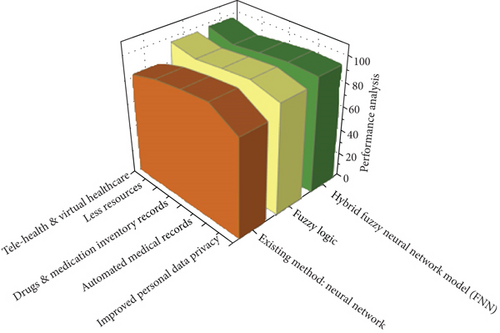
| Hospital financial sectors | Existing method: neural network (%) | Fuzzy logic (%) | Hybrid fuzzy neural network model (FNN) (%) |
|---|---|---|---|
| Improved personal data privacy | 82.13 | 91.32 | 96.35 |
| Automated medical records | 95.58 | 97.57 | 97.13 |
| Drugs & medication inventory records | 93.45 | 95.35 | 94.65 |
| Improved medical adherence for patients | 90.12 | 92.56 | 91.46 |
| Less resources | 83.35 | 96.63 | 97.56 |
The comparison analysis for Table 4 depicts a patient’s information obtained upon that server after having received data collected via sensors and forwarded via smart device. The report is divided into three segments: data from the patient, sensor information, and the patient’s illnesses. On the other hand, patients receive correct prescriptions and treatments on time, which is the primary goal of any healthcare company. The pharmaceutical and drug inventory is well-maintained and mechanized. The information concerning the patients’ medication adherence is kept track of. When opposed to old approaches, medical record maintenance is orderly and automated. Scheduling, registration, medical records, billing, claims, clinical, financial, accounting, nursing, and other services are provided via cloud technology. As a result (refer Table 4), hospital finance management is streamlined by reducing total resource consumption and automating various activities. With cloud technology and wireless network system, hospitals’ overall operational costs are significantly decreased.
Because the primary goal of f1 tof4 in equations is really to decrease an energy state’s financial delay time, desirability is defined in terms of time delay; however, less time latency equates to greater quickness. The fuzzy logic system makes the decision, and the decision accuracy is based on the equations evaluated (Figure 7). According to Table 4, the suggested service’s accuracy ranges from 97% to 100%. It showed that the suggested system operates in accordance with the rules established for patient safety and management solution decision-making. To the time it has taken the general practitioner to react to the queries. The suggested scheme is a low-cost and efficient solution for people living in remote areas; those who could use it to determine if they have a serious health problem and treat it accordingly by notifying nearby hospitals financial management. Using detectors and decision support tools in hospital financial management is a novel concept, and it reduces time constraints when compared to traditional telemedicine methods.
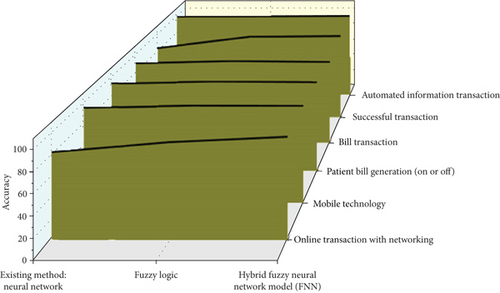
4. Conclusions
The traditional healthcare system relies on many individuals working together to keep tabs on the health of patients, the availability of medications, and surgical supplies. There was also a shortage of funds in the hospital’s financial management administration department. Modern advances in healthcare financial management technology are embraced by hospital financial management administration as a solution to difficulties. Financial management systems are gradually using sophisticated systems to keep tabs on product ideas and patient wellness. Smart quality financial management systems with fuzzy control models are the goal of the suggested research. In order to test the notion, researchers are gathering sensor data from a variety of patients, but they will conduct an analysis. Smart healthcare management and monitoring using fuzzy logic has special problems. One or more healthcare system models may be integrated to solve a specific issue when one is insufficient. A hybrid system is formed when a number of different models are put together to solve a specific problem. The hybrid fuzzy neural network model is a blend of fuzzy logic systems and neural networks (FNN). This model is implemented in this study and proved that it has obtained accuracy of 97.56%. It states that the proposed model works well in optimizing the accuracy of hospital financial management.
Conflicts of Interest
The authors declare no conflicts of interest.
Open Research
Data Availability
The data used to support the findings of this study are available from the corresponding author upon request.




